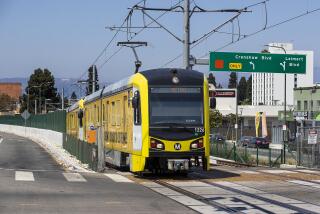Bullet train’s eventual link to L.A. rail system far from clear-cut

As California’s bullet train officials begin to lay plans for the system’s Los Angeles segment, a major technical issue is coming under close scrutiny: incompatibility between the sleek, high-speed electric trains and the region’s older, diesel-powered commuter rail network.
The state’s plan for initial passenger service calls for high-speed trains to shuttle between Merced and Burbank by 2022, a first leg of a $68-billion line that eventually is expected to link Los Angeles and San Francisco.
Under the current design, Los Angeles-bound passengers pulling into Burbank, at least in the early years of operation, would have to transfer to a diesel-powered commuter train on another platform for the final 13-mile trip to downtown’s Union Station.
It would be an inconvenience for passengers, and, critics say, at odds with the bullet train’s long-promoted goals of fast and environmentally friendly transportation.
Some transportation experts and government officials are pushing for design changes that would offer riders a “one-seat ride” between the Central Valley and downtown, or even Orange County, from the start of service.
That could be accomplished, proponents of the change say, by blending the operations of Metrolink and the high-speed system through track-sharing and electrification of part of the Metrolink system, much like what the state is doing with local commuter rail service in the Bay Area.
Thus far, Metrolink officials have been cool to the idea, citing, among other things, the cost and complexity of overlapping operations.
Start of construction of the bullet train’s L.A. section is at best years away. But the emerging debate reflects the long-range effects of key decisions now being made on specific routes, and the design of the trains, station platforms and other parts of the system.
The issues directly affect whether and how the two systems could be integrated in Southern California. If the issues are not fully considered early on, some experts warn, the option to coordinate Metrolink and high-speed rail operations could be foreclosed, jeopardizing the system’s long-term success.
Paul Dyson, president of the Rail Passenger Assn. of California and a member of the Burbank Transportation Commission, has asked California High-Speed Rail Authority board chairman Dan Richard and Metrolink board chairman Larry McCallon to consider electrifying a portion of the Metrolink line.
The cost of installing an electrical system, buying new electric rail cars and operating a mixed system of electric and diesel trains is unknown. But Dyson said it would pay off in improved passenger convenience, the possibility of more frequent service and increased rail ridership for both the high-speed rail system and Metrolink.
Michael Cano, a transportation aide to L.A. County Supervisor Mike Antonovich, whose district includes Burbank, said the supervisor’s office agrees with Dyson. “We should look at electrification,” he said.
Louis Thompson, chairman of the state’s High-Speed Rail Peer Review Group, an advisory panel on the project, said the possibility of track-sharing requires study now to ensure it’s at least an option in the future. “The arrival of high-speed rail and the potential for joint operations makes the issue of electrifying Metrolink more important and immediate,” Thompson said.
Electric trains accelerate much faster than diesel-powered trains, and are cleaner and more energy efficient. In addition, electrifying Metrolink would allow it to use the new high-speed rail track that will be built between Burbank and Palmdale, speeding up what is now a roughly two-hour trip, Dyson said. In addition, high-speed rail would be able to use Metrolink’s track system, if it were electrified, between Burbank and possibly Anaheim until its own track system is completed.
Such a joint operation could involve trade-offs and compromises in the speed and frequency of bullet train service, just as it is doing in the Bay Area’s blended system.
Richard, chairman of the bullet train board, recently wrote Dyson that he is willing to discuss electrification proposals and said the authority is evaluating similar ideas. He did not elaborate, but rail authority spokeswoman Lisa Marie Alley stressed that the route and operational design details for the L.A. County segment of track are still in the early planning stages.
Metrolink’s chairman, McCallon, has argued that electrifying the system would be “very cost prohibitive.”
In an interview, he said, “Transfers in Burbank would be acceptable.”
But the benefits of an integrated operation could be substantial for Metrolink, Dyson said. The six-county service’s 20,000 round-trip riders per day after 20 years of service “is a huge disappointment and a failure,” he said.
“The only way to make anything out of it is to create a truly regional service and invest in a modern system like exists in Paris and Berlin,” Dyson said. “High-speed rail could be the catalyst for that.”
One key challenge involves making sure different types of rail cars would be level with station platforms. Having platforms level with train doors on any rail service is critical to efficiently moving passengers on and off.
But such designs are not easy to coordinate.
During a state legislative committee hearing this year, Thompson noted that bullet train doors would be 25 inches higher than existing train doors on Caltrain’s cars in the Bay Area, where blended service is being planned.
Last week, Caltrain issued a formal plan to electrify its system and is moving ahead with ordering equipment. But, at this point, its trains could still have different door heights, meaning bullet trains and commuter trains might not be able to share the same platforms.
The state and Caltrain are discussing a common standard for station design and train door heights and may be close to an agreement on a standard, said high-speed rail spokeswoman Alley.
Such issues are likely to affect Metrolink, if officials pursue the idea of blended service. Metrolink spokesman Jeff Lustgarten noted that not all of Metrolink’s stations have uniform platform heights, because they are owned and operated by the cities where they are located. Passengers currently climb up stairs into the cars.
Lustgarten also noted that Metrolink is investing in new locomotives that have the cleanest diesel technology, cutting emissions by 80% over the current fleet.
Metrolink hasn’t had to think about sharing rail because, unlike the Bay Area, the bullet train ultimately is supposed to have its own tracks all the way to Union Station.
That theoretically could allow trains to roar through the San Fernando Valley at 220 mph.
But that isn’t scheduled to happen until 2028, six years after Merced-to-Burbank service is expected to begin.
Given uncertainties about future funding and other issues, Dyson and others predict it will be well past 2028 when the bullet train tracks reach Union Station. In the meantime, Dyson argues, delays in service and requiring passengers to change trains to reach L.A. could severely crimp ridership.
Elizabeth Alexis, co-founder of a Bay Area group that has been strongly critical of the high-speed rail project, said stopping bullet train service at Burbank for years will essentially make the eastern San Fernando Valley the terminus of the system. That in turn would require major investments in parking lots and other maintenance operations, she said, that normally are built at a rail system’s end points.
“It is a bad idea,” she said.
For now, the state will only say it is weighing a variety of alternatives for extending high-speed rail into L.A. County. “We are looking at all of the options,” Alley said.
More to Read
Sign up for Essential California
The most important California stories and recommendations in your inbox every morning.
You may occasionally receive promotional content from the Los Angeles Times.










